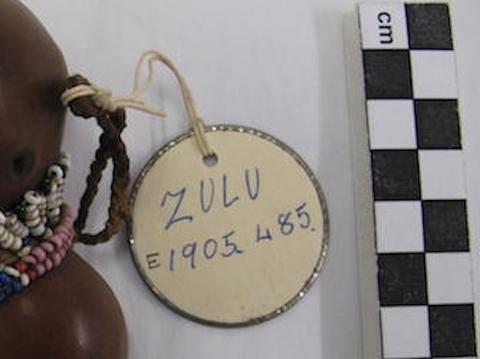Área de título y declaración de responsabilidad
Título apropiado
Circular label with metal outline tied to object
Tipo general de material
- Objeto
- Documento textual
Título paralelo
Otra información de título
Título declaración de responsabilidad
Título notas
- Fuente del título: Rachel Hand for MAA
Nivel de descripción
Unidad documental simple
Institución archivística
Código de referencia
Área de edición
Declaración de edición
Declaración de responsabilidad de edición
Área de detalles específicos de la clase de material
Mención de la escala (cartográfica)
Mención de proyección (cartográfica)
Mención de coordenadas (cartográfica)
Mención de la escala (arquitectónica)
Jurisdicción de emisión y denominación (filatélico)
Área de fechas de creación
Fecha(s)
-
2016 - (Online curation)
-
YYYY (Making)
Área de descripción física
Descripción física
Área de series editoriales
Título apropiado de las series del editor
Títulos paralelos de serie editorial
Otra información de título de las series editoriales
Declaración de responsabilidad relativa a las series editoriales
Numeración dentro de la serie editorial
Nota en las series editoriales
Área de descripción del archivo
Historial de custodia
[Source - Rachel Hand for MAA, 2016: The Museum’s catalogue cards and labels are part of the institution' and the objects' very history. Catalogue cards were created to add additional object information from the very first accessions back in 1884 and replacement cards were made if the original was lost, usually using both different pens and terms. Original sale or collector labels could be stuck to the cards to add biographical layers of information in the same way that letters and later photographs were sometimes attached to cards. Staff and sometimes visitors would add comments on provenances, measurements and locations over time. Reconnecting an author with their annotations can add to our knowledge of the object’s history and associations. The era and author of the cards also is reflected in their physical aspects: initially details were handwritten in ink, the 1930s saw cards stamped and written on a typewriter, followed variously by handwritten details in ballpoint pen, finally moving to word-processed and laser printed texts.
Like the cards the physical type of paper and pen used can suggest dates as well as authors. They can be used to confirm the identity of misplaced objects, e.g. Henry Bulwer’s collection bears distinctive long, rectangular shaped paper labels and his cursive script.
Early labels were handwritten in ink, on small rectangular paper or parchment label and tied through small metal reinforced holes. Others were glued directly to the object. Smaller rectangular or square paper labels, with a printed outline, usually stuck directly to the object, usually originate in late nineteenth or early twentieth century salerooms or via a collector. Larger circular, metal-edged labels were written in the museum, probably from the 1970s onwards. The 1980s bought larger labels on thick yellow paper, and remained handwritten. From c.2000, we have used acid-free yellowish paper labels, that are written on in light-sensitive and waterproof ink.]
Alcance y contenido
Área de notas
Condiciones físicas
Origen del ingreso
Arreglo
Idioma del material
Escritura del material
Ubicación de los originales
Disponibilidad de otros formatos
Restricciones de acceso
Condiciones de uso, reproducción, y publicación
Creative Commons License: CC BY-NC-ND
https://creativecommons.org/licenses/by-nc-nd/3.0/
Unless otherwise stated the copyright of all material on the FHYA resides with the contributing institution/custodian.
Instrumentos de descripción
Materiales asociados
Acumulaciones
Nota general
Accession numbers
[Source - Nessa Leibhammer for FHYA using MAA materials, 2012: Cat ID: 109232; ID NO: E 1905.485; MAA num: A.R.1906.797]
Nota general
Attributions and conjectures
[Source - MAA, 2012:
Names: Box - MAA (01/12/1998); Gourd - MAA (01/12/1998)
Keyword: Containers; Narcotics and Intoxicants
Material: Plant; Glass; Bead; Fibre
Descriptions: Snuff box made from a bottle-shaped gourd with glass bead collar - MAA (01/12/1998)
Cultural Group: Zulu
Date Made:
Dimensions:
Source: Haddon, A. C. (collector and donor)
Source Date: 1905
Place: Africa; Southern Africa; South Africa; Zululand - MAA (01/12/1998);
Contexts: Collected during British Association visit to South Africa 1905 - MAA (01/12/1998, updated: 22/07/2008)
Created: 01/12/1998]



Material contributed by members of the public
Building an archive is a collective endeavour. Please help us grow the FHYA knowledge base.
If you want to add information to this page you can insert a hyperlink, add files and/or text to the box below.
In the case of material relevant to the FHYA as a whole please upload information HERE.
The FHYA does not vet this material but reserves the right to remove anything deemed to be racist, homophobic, sexist or otherwise offensive. Everything on the FHYA is licensed under a Creative Commons CC BY-NC-ND licence.
To make a contribution you must be a registered user. To register an account, click here. Note that after registration you will not be automatically redirected to this page.
If you have already registered but are not logged in, log in here.